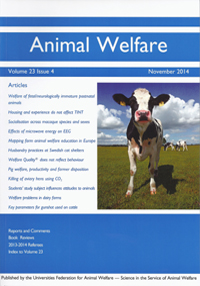Document type : Scientific article published in Animal Welfare
Authors: B.H. Eagan, E. Gordon, D. Fraser
Preview: This study assessed how sound affected fear- and maintenance-related behaviour in singly housed cats (Felis silvestris catus) in an animal shelter. Two daily 30-min observation sessions (morning and evening) were made for 98 cats from admittance for ten days or until the cat was removed. Cat behaviour and presence of sound (classified by the source) were recorded by instantaneous and onezero sampling with 15-s intervals. Each 30-min observation session was classified as 'quiet' or 'noisy' if the one-zero score for presence of sound was above or below the median of sessions at that time of day. To ensure that cats had at least two complete days of comparable observations, statistical analysis was restricted to the 70 cats (30 females, 40 males) present for two or more weekdays. Cats varied widely in the amount of fear and maintenance behaviour they performed. Males showed less fear and maintenance behaviour than females. Morning sessions consistently had much more sound than evenings, and cats showed more fear behaviour and less maintenance behaviour in the mornings. Cats showed more fear behaviour in noisy morning sessions than quiet ones, with no comparable difference in maintenance behaviour. Where sessions included a pronounced transition in sound, fear-related behaviour was more common after a transition from quiet to noisy and less common after a transition from noisy to quiet. The results show that shelter cats vary greatly in their responses and suggest that sound in shelter environments can substantially affect their behaviour. Lowering sound levels in shelters may help improve cat welfare.






